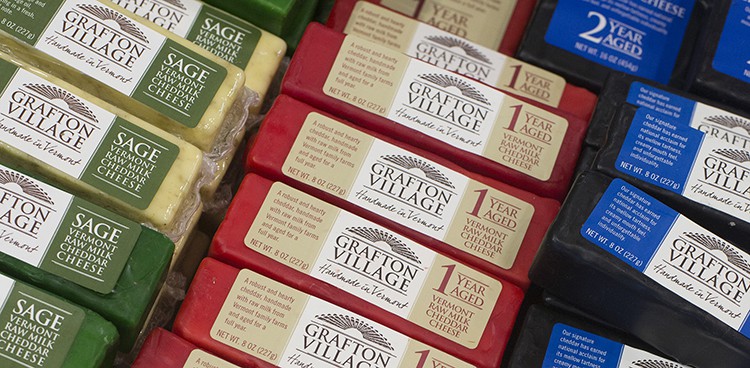
Double Vision is featured in our Summer 2017 issue.
“Cheddar is a crowded category,” says Meri Spicer, vice president of sales and marketing at Grafton Village Cheese. She’s right: The segment is so saturated that the phrase “Vermont cheddar” conjures a specific texture and flavor profile (firm yet creamy, savory, and sharp) even for those not immersed in the artisan cheese community.
Grafton’s steady stream of awards—its cave-aged rounds and cheddar blocks have snagged ribbons at the United States Championship Cheese Contest, the International Cheese Awards, the World Cheese Awards, and the Good Food Awards—and 52 years of continuous operation have cemented the company’s presence on the food scene. But the creamery isn’t content to rest on its laurels; according to Spicer and other staffers, Grafton is just getting started.
THE CHEDDAR EVOLUTION
Founded in 1892, Grafton Village Cheese—like many other creameries—was born out of necessity. Farmers in Grafton, Vt., needed a way to preserve their fluid milk prior to the advent of home refrigeration, so they created a cheesemaking cooperative. Twenty years later, a fire destroyed the creamery, and cheddar production ceased. Over the following decades, the local economy sagged and population dwindled. This saddened Dean Mathey, a wealthy resident of Princeton, N.J., with family ties to the Green Mountain State—so he decided to take action.
Mathey founded the Windham Foundation in 1963 to revitalize Grafton. His first priority: create industry. So the Windham Foundation resurrected the cheesemaking company that year, along with the circa-1801 Grafton Inn.
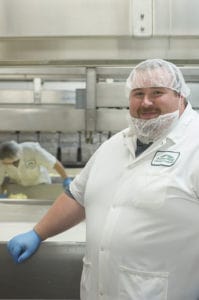
Production supervisor Greg Joslyn makes cheddar
Grafton Village Cheese began producing block cheddar with raw cow’s milk from area co-ops, eventually offering the cheese at varying ages. Older cheddars, however, weren’t part of the initial plan. “It wasn’t like, Oh, we’re going to make this [at different ages]. It was: Oh, crap, we’ve got a bunch of 2-Year [Cheddar] . . . what do we do?” says Greg Joslyn, a production supervisor with the company for 18 years. “Around the time I started is when we introduced 3-Year [Cheddar]. We thought it was pretty good, so we said, Let’s see what happens when it goes to four years. We had it all the way up to six years.” As time passed, Grafton honed its maturation process and began crafting cheese with the intent of aging it. Today its one-, two-, three-, and four-year aged cheddars are available, in addition to flavored varieties.
“Flavors don’t make up a huge part of our business, but they’re something people get excited about,” says Vince Razionale, director of the cave program and sensory analysis. Grafton approaches these cheeses carefully, developing varieties that consumers can savor with a glass of wine. The team isn’t in it for the novelty.
“We don’t just throw in a bunch of spices and call it good,” Spicer says. In addition to Grafton’s newest releases—Smoked Chili Cheddar and Truffle Cheddar—the brand also offers Maple Smoked Cheddar, Garlic Cheddar, and Sage Cheddar.
GREEN MOUNTAIN SPIRIT
In 2008, Grafton opened a second creamery in Brattleboro, 27 miles south of the original plant. To ensure its cheese would have the same taste of place no matter where it was made, the creamery employed a technique used heavily in the industry. “We brought in buckets of whey from Grafton and threw them all over the floors [of the Brattleboro facility],” Joslyn says. (The liquid helped recreate Grafton’s specific microbiome.)
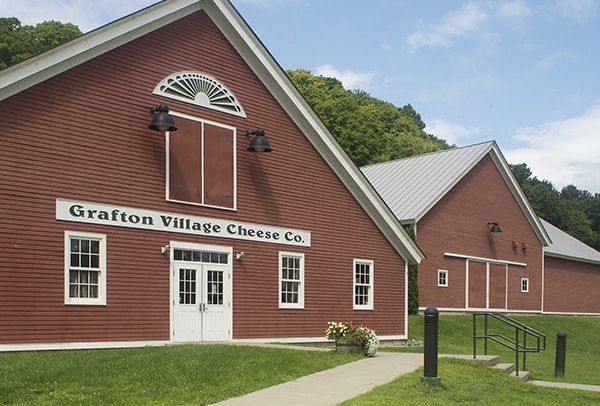
The Brattleboro facility houses a creamery and cheese shop
The Brattleboro location also boasts a sprawling shop, offering local and international wheels and wedges in addition to Grafton cheeses, plus other Vermont products such as preserves, maple syrup, specialty chocolates, and even homemade dog treats. “We don’t ever think of other—particularly Vermont—cheesemakers as competitors. We think of them as collaborators,” Spicer says. “We’re all in the business of growing the artisan cheese community.”
The Windham Foundation also owns Grafton Ponds, an all-seasons outdoor center, and hosts Grafton Conferences, informal debates of key public policy issues facing Vermonters (up next: how to preserve and promote a recreational forest economy). All proceeds from the three companies—Grafton Village Cheese, the Grafton Inn, and Grafton Ponds—are funneled back into the foundation, which supports area communities by providing scholarships to graduating high school seniors and grants to other nonprofits dedicated to social services, the arts, and education.
“Grafton Village Cheese is an integral part of allowing dairy farmers and cheesemakers to continue [their work],” says Steve Millard, senior vice president of merchandising and operations at Murray’s Cheese in New York City. (The company sells Grafton’s products and also fulfills its mail-order business.)
For Spicer, even working at Grafton feels a bit like activism. “We’re buying milk, we’re providing jobs; we’re buying salt, cultures, rennet, and ingredients,” she says. “All of that is adding to the rural economy here.”
ANOTHER DOOR OPENS
In 2010, cheese artisan Dane Huebner joined the Grafton team—a major hire that ushered in a new era for the business: cave-aged, natural-rind cheeses. “We were watching where society was going in terms of interest in food and knowledge surrounding food,” Spicer says. “That’s when we decided to start the cave-aged line.”
The creamery’s four caves are located at the Grafton facility, with two caves for natural-rind cheeses and two caves for washed-rind cheeses. “Our caves are very small—small compared to other producers and a small percentage of what we do—but they’re very full,” says Razionale, who replaced Huebner in 2016.
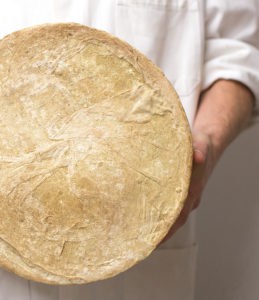
A wheel of Clothbound Cheddar
Currently, Grafton produces the following cave-aged cheeses: Clothbound Cheddar, which accounts for half of all cave production; Shepsog, a mixed-milk (cow and sheep) wheel; and Bear Hill, a sheep’s milk Alpine style. On the horizon: a semi-soft cow’s milk wheel called Saxtons River, a non-GMO cheese, and a cow’s milk version of a previously retired sheep’s milk round.
If you can find it, stock up on Queen of Quality Clothbound Cheddar, a special reserve edition made with Jersey milk from nearby Spring Brook Farm in Reading, Vt. Grafton also collaborates with affineur Crown Finish Caves in Brooklyn, N.Y., to turn out Windham, another natural-rind cheddar available exclusively at Whole Foods, and Bismark, a sheep’s milk cheddar-Pyrenees style hybrid.
Ewe’s milk was once tricky for Grafton to secure, as the animals are notoriously stingy seasonal producers. But recently it found a new source just a state away. “These are real Amish—they do everything with horse-drawn plows and in many cases there are diversified farms,” says Razionale of the 11-family group in Upstate New York that supplies Grafton’s raw sheep’s milk. “They aren’t just [raising] sheep, they’re growing vegetables . . . David, whose house we went to back in November, had, like, 80 turkeys in his front yard.”
UNDER CONSTRUCTION
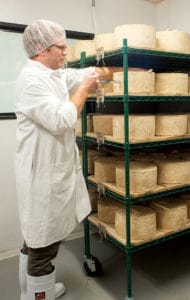
Director of the cave program and sensory analysis Vince Razionale tests the readiness of a wheel using a cheese trier
At Grafton, work is never done, especially when it comes to boosting quality. Each wheel and block is tasted regularly as it ages to ensure that it’s sent out for sale right when it’s ready. Razionale, who leads the charge on cheese grading, is excited about the process. “I think it’s fair to say that the quality of our cheese is going to improve,” he says. “We’re all still learning, right? What should a three-year cheese taste like when it’s six months old?”
Grafton is answering that question through research and development. “We do R&D on [block] cheddar,” Joslyn says. “We’re always looking to make our recipes better.” These experimental batches, which are typically very small, are crucial for a company that matures its product as long as Grafton does.
“When you make aged cheese, mistakes take five years to correct,” Spicer says. She’s speaking from firsthand knowledge: Production errors several years ago caused Grafton to run out of both 3- and 4-Year Cheddar. Luckily for turophiles, inventory is starting to trickle back in—currently the 3-Year is available in limited quantities and 4-Year will be ready again in 2018.
It’s lucky for Grafton, too. “I hate to use the word sexy,” Spicer says, “but the cheeses that get attention, the ones that people post about on social media, the ones that win awards . . . tend to be our older cheddars and cave-aged cheeses.” No surprise, then, that Grafton is planning a cave expansion scheduled for completion in the next two years.
THE BOTTOM LINE
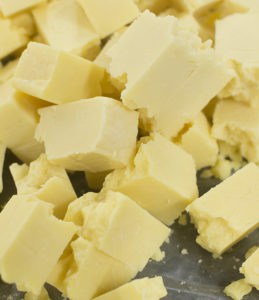
Cubes of iconic Vermont cheddar
Though it’s the aged cheddars and natural-rind wheels that often garner Grafton press, the creamery’s younger and flavored cheddar blocks are just as important—if not more so—when it comes to sustaining the business. “The 1- and 2-Year cheddars and Maple Smoked Cheddar pay our salaries, quite frankly,” Spicer says. “They keep the lights on; they pay the bills.”
To do this, the bars must have wide distribution, yet some in the artisan community see this accessibility as a negative—mongers may not want to stock a cheese that’s also for sale at their local grocery store. “There’s this expectation among cheesemongers—and this isn’t unique to cheese, it’s everywhere in [specialty] food—that the artisan should have to sweat a little harder,” says Razionale, a former monger at Formaggio Kitchen in Cambridge, Mass. “It’s romantic and cool, but it’s also kind of unfair.”
At a time when small creameries are struggling to stay afloat (Washington, D.C.’s Sona Creamery closed in 2016; Georgia’s Many Fold Farm and Minnesota’s The Lone Grazer shuttered earlier this year), economic viability is more important than ever. Millard of Murray’s Cheese recognizes that: “Grafton should not be penalized for growing their business. [Cheese] should not be elitist. [At Murray’s] we don’t deem this cheddar less worthy because it was in a grocery store. We believe firmly in elevating the specialty industry and making great cheese more approachable.”
So let’s celebrate the fact that supermarkets are stocking specialty curds. After all, Grafton wouldn’t be in a position to give so much to their community without such mass appeal.




